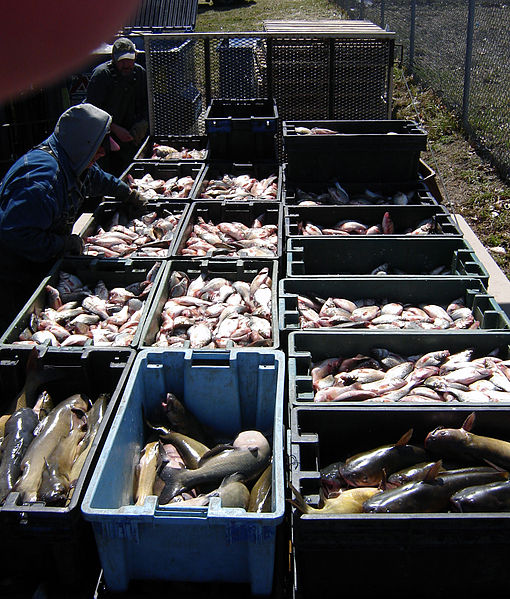
Lake Erie white bass and catfish bound for New York supermarkets. Image: Mike Sharp via wikimedia
By Josh Bender
Commercial overfishing may not pose the same threat to the Great Lakes’ top predators that it poses to their marine counterparts, according to researchers at the Canadian Fisheries Research Network, a group of commercial, government and academic aquatic scientists.
The researchers presented their work, including a study on the Lake Erie yellow perch fishery, at the recent International Association of Great Lakes Researchers conference.
While the number of ocean-dwelling predators such as bluefin tuna and Atlantic cod have suffered overfishing, differences in industry practices make overfishing less likely in the Great Lakes, said Kevin Reid, a researcher with the network and an assessment manager for the Ontario Commercial Fisheries Association.
The fish sought by marine fishers often require specialized equipment and licensing, limiting their ability to pursue a variety of fish, he said. Nets used by Lake Erie fishers can be used to catch several varieties of commercially viable fish.
That flexibility makes it easier for the Lake Erie fishers to ply their trade without harvesting unsustainable amounts of any particular species, he said.
The network is slated to release several other studies of Great Lakes commercial fishing by the end of 2016.
The studies indicate that commercial overfishing is a much less substantial threat to the Great Lakes than previously thought, said Tom Nudds, the project’s leader and a University of Guelph integrative biologist.
Thanks for the response. Deep topic, certainly. But I was not referring to ‘stocked exotic salmonids’ per say — I suggest looking into the positive impacts of tribal fisheries who are stocking native fish. For example, at Keweenaw Bay Indian Community in the U.P. “biologically and genetically unique strains of fish for its hatchery programs, including the Jumbo River strain of brook trout, Traverse Island strain of lake trout, and unique strains of coaster brook trout from Isle Royale, to name a few.” http://nrd.kbic-nsn.gov/stocking
The current management situation leaves gaping holes in commercial/tribal fisheries supervision. Having a situation where two groups each control half the fishery and cannot regulate or enforce the other half leaves the system open for exploitation of fisheries stock without the ability to enforce penalties. The authors data, if pertinent, is pertinent to Erie only.
Dear Kathleen,
That is a good question. Our research was primarily focused on the Lake Erie fishery and ecosystem where predator stocking is much lower than it is on Lakes Ontario, Huron and Michigan. Commercial harvesters are not allowed to harvest the exotic salmonids that are stocked in the Great Lakes, so those species are not available for them to switch to when one of their primary target species goes into decline and/or quotas are reduced. The Lake Erie predators that we examined were walleye, white bass white perch and yellow perch. We did not include any salmonids because these are not available to the commercial fishery. Unlike the fisheries of the Great Lakes, stocking is little used in marine fisheries. More research is needed if we are to understand if the stocked exotic salmonids you refer to are a stabilizing or destabilizing force in the GL ecosystem.
Best,
KR
BS! I believe these guys as much as I believed the tobacco companies who did studies that showed no ill effects from smoking. The only reason a commercial fisherman switches to an alternate species is when he can’t catch enough of the primary species to make it pay. By the time the population is that depressed, it’s ability to recover is doubtful.
Also, what role do Tribal, State and Provincial fisheries play in this sustainability differential, given their substantial annual stocking efforts? Commercial fishing might be only half of this story. How many fish are entering each system through stocking activities (Great Lakes freshwater v. marine)?